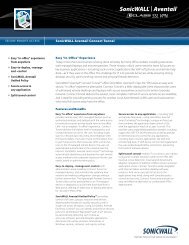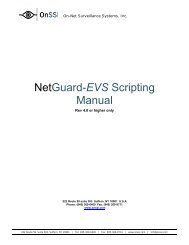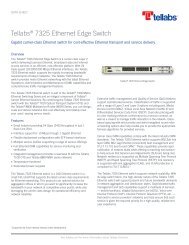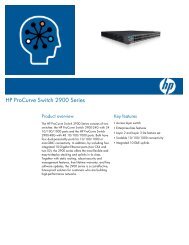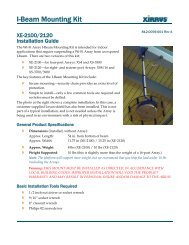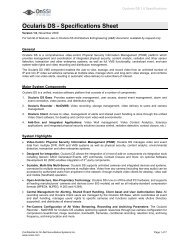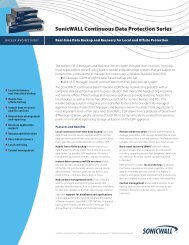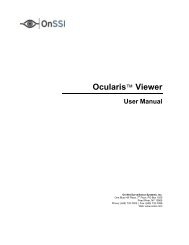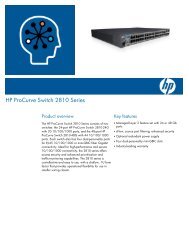HP ProCurve Networking Datasheets - Moonblink
HP ProCurve Networking Datasheets - Moonblink
HP ProCurve Networking Datasheets - Moonblink
Create successful ePaper yourself
Turn your PDF publications into a flip-book with our unique Google optimized e-Paper software.
<strong>HP</strong> <strong>ProCurve</strong> Switch 8212zl<br />
Features and benefits (continued)<br />
NEW Management Interface Wizard: CLI-based step-by-step<br />
configuration tool to help ensure that management interfaces<br />
such as SNMP, telnet, SSH, SSL, Web, and USB are secured to<br />
desired level<br />
• Switch CPU protection: provides automatic protection against<br />
malicious network traffic trying to shut down the switch<br />
• ICMP throttling: defeats ICMP denial-of-service attacks by<br />
enabling any switch port to automatically throttle ICMP traffic<br />
• Identity-driven ACL: enables implementation of a highly granular<br />
and flexible access security policy specific to each authenticated<br />
network user<br />
• BPDU port protection: blocks Bridge Protocol Data Units (BPDU)<br />
on ports that do not require BPDUs, preventing forged BPDU<br />
attacks<br />
• Dynamic IP lockdown: works with DHCP protection to block traffic<br />
from unauthorized hosts, preventing IP source address spoofing<br />
• Dynamic ARP protection: blocks ARP broadcasts from<br />
unauthorized hosts, preventing eavesdropping or data theft of<br />
network data<br />
• Detection of malicious attacks: monitors ten types of network<br />
traffic and sends a warning when an anomaly that potentially can<br />
be caused by malicious attacks is detected<br />
• Port security: allows access only to specified MAC addresses,<br />
which can be learned or specified by the administrator<br />
• MAC address lockout: prevents configured particular MAC<br />
addresses from connecting to the network<br />
• Source-port filtering: allows only specified ports to communicate<br />
with each other<br />
• TACACS+: eases switch management security administration by<br />
using a password authentication server<br />
• Secure Shell (SSHv2): encrypts all transmitted data for secure,<br />
remote command-line interface (CLI) access over IP networks<br />
• Secure Sockets Layer (SSL): encrypts all HTTP traffic, allowing<br />
secure access to the browser-based management GUI in the<br />
switch<br />
• Secure FTP: allows secure file transfer to/from the switch;<br />
protects against unwanted file downloads or unauthorized<br />
copying of switch configuration file<br />
• Switch management logon security: can require either RADIUS<br />
or TACACS+ authentication for secure switch CLI logon<br />
• Security banner: displays a customized security policy when<br />
users log in to the switch<br />
• USB Secure Autorun (requires <strong>HP</strong> <strong>ProCurve</strong> Manager Plus):<br />
deploys, diagnoses, and updates switch using USB flash drive;<br />
works with secure credential to prevent tampering<br />
• STP Root Guard: protects root bridge from malicious attack or<br />
configuration mistakes<br />
Convergence<br />
• IP multicast routing: includes PIM Sparse and Dense modes to<br />
route IP multicast traffic<br />
• IP multicast snooping (data-driven IGMP): automatically prevents<br />
flooding of IP multicast traffic<br />
• LLDP-MED (Media Endpoint Discovery): a standard extension of<br />
LLDP that stores values for parameters such as QoS and VLAN<br />
to automatically configure network devices such as IP phones<br />
• RADIUS VLAN for voice: uses standard RADIUS attribute and<br />
LLDP-MED to automatically configure VLAN for IP phones<br />
• PoE allocations: supports multiple methods (automatic, IEEE<br />
802.3af class, LLDP-MED, or user specified) to allocate PoE<br />
power for more efficient energy savings<br />
Quality of Service (QoS)<br />
NEW Advanced classifier-based QoS: classifies traffic using<br />
multiple match criteria based on L2/3/4 information; applies<br />
QoS policies such as setting priority level and rate limit to<br />
selected traffic per port or per VLAN<br />
• Layer 4 prioritization: enables prioritization based on TCP/UDP<br />
port numbers<br />
• Traffic prioritization: allows real-time traffic classification into<br />
eight priority levels mapped to eight queues<br />
• Bandwidth shaping:<br />
– Port-based rate limiting: per-port ingress/egress enforced<br />
maximum bandwidth<br />
– Classified-based rate limiting: use ACL to enforce maximum<br />
bandwidth for ingress traffic on each port<br />
– Guaranteed minimum: per-port, per-queue egress-based<br />
guaranteed minimum bandwidth<br />
• Class of Service (CoS): sets the IEEE 802.1p priority tag based<br />
on IP address, IP Type of Service (ToS), L3 protocol, TCP/UDP<br />
port number, source port, and DiffServ<br />
6



